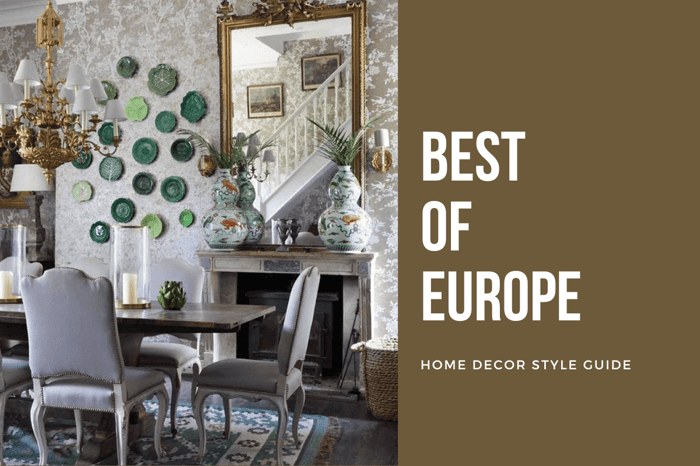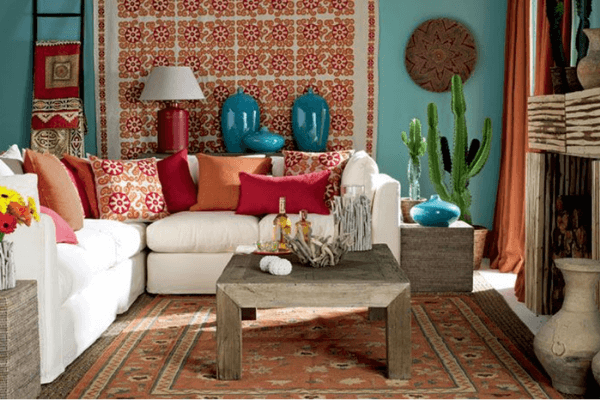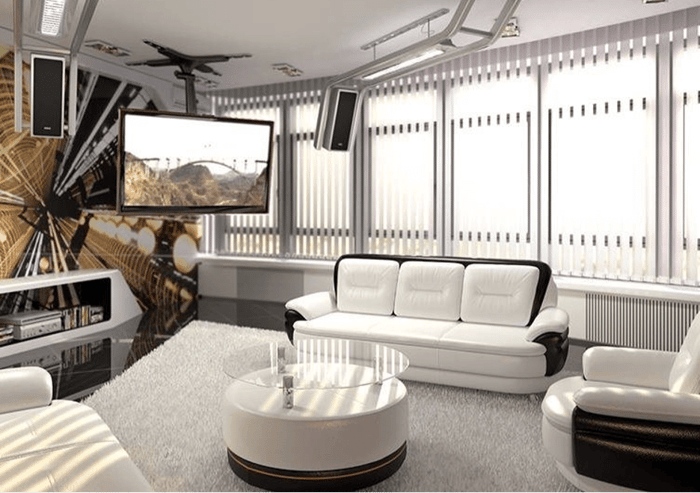The immediate idea of a German style home is one of neat and tidy wood style cottages with heavy wood furnishings and European decor. The whitewashed exteriors with dark wood sectional dividers of half-timbered houses are the historical and stereotypical models. 20th and 21st living has changed some of those classical styles as space has become an issue as homes and apartments have downsized, thus the interior decor has slimmed as well, leading to the post modern and minimalist look.
 The German population is composed of several different generations, social classes, religions, and a combination of 180 different nations. ”According to a study, 53 percent of Germans think that the home should be an expression of their personality,” as reported by Deutschland.de, where you can find everything about Germany. With this ideal in mind, you’re going to find a combination of many home decor styles in a German interior.
The German population is composed of several different generations, social classes, religions, and a combination of 180 different nations. ”According to a study, 53 percent of Germans think that the home should be an expression of their personality,” as reported by Deutschland.de, where you can find everything about Germany. With this ideal in mind, you’re going to find a combination of many home decor styles in a German interior.
HISTORY
The “great-grandfather” of the German style was the Biedermeier, which has many other names: neo-Renaissance, ancient Germanic, or Altdeutsch. Biedermeier furniture design in Germany during the years 1815–1848 and was based on utilitarian principles. The furniture style was simple and elegant. Its construction utilized the ideal of truth through materials. As a result of this ideal, the wood grain was the key decorative element in the design of the furniture.
 As the grand luxury ‘Empire style’ was dying out and longer fit into the new small homes that were replacing mansions, Biedermeier style was a downsize and refinement of the Empire style. Gothic details and a slimmed down modern look started to emerge.
As the grand luxury ‘Empire style’ was dying out and longer fit into the new small homes that were replacing mansions, Biedermeier style was a downsize and refinement of the Empire style. Gothic details and a slimmed down modern look started to emerge.
In the 1930s a new German style started to blossom. Students of the “Bauhaus” school came up with the concept of a modern, concise, and practical design. The direction represented the quintessence of modernity and minimalism with a few national characteristics.
 TYPICAL GERMAN STYLE
TYPICAL GERMAN STYLE
The German design style is characterized by large free spaces, a combination of a dark floor with light wall decoration, rounded lines, podiums, and functional furniture. A classic Ikea look or designer furniture, heavy oak wall units, items discovered at the flea-market, or upcycled furniture from wooden palettes. The floor is covered with laminate or carpets, the walls are decorated with woodchip wallpaper or brightly colored paint. Minimalism or lavish ornamentation – you will find all of these things on entering people’s homes in Germany. Since housing is becoming increasingly scarce in cities, people are making do with less room, thus ideas for living in small spaces are trendy.
 GERMAN STYLE FEATURES
GERMAN STYLE FEATURES
The German style is characterized by the following features:
- An ideal, well-balanced equilibrium between functionality and comfort.
- Skillful arrangement of furniture.
- A conscious layout of convenience and flow.
- Convenience before beauty.
- Calm color palette based on white and shades of brown.
- The moderate use of decorative elements.
- Angular furniture combined with soft curves.

- White and chocolate
- Shades of brown, coffee, and vanilla
- Terracotta, sepia, and bronze
- Combination of black and gray
- Yellow, Prussian blue, royal purple
- Rare accents of red, cherry, and wine

INTERESTING INFO
In Germany “4ZKB” is the code for a typical German apartment. It stands for four rooms plus kitchen and bathroom. A second B at the would mean the apartment then has a balcony. A normal layout involves a hall with a coat rack, a living room, bedroom, children’s room, kitchen, and bathroom.
Privacy
Many Germans regard their homes and apartments as havens of privacy. Curtains are typical. Yards are surrounded by fences. Spontaneous visits are uncommon; even close friends call ahead before dropping by.
FLOORS
Flooring is traditionally in hardwood with modern updates of laminate, parquet, or tiles.
 FURNITURE
FURNITURE
As stated previously, function is king in German decor with aesthetics coming in second. Surfaces are smooth with minimal decorative elements. Angular large pieces are balanced with softer lines of accompanying items. They like interiors with classic proportions:
- Comfortable armchairs
- Soft sofas
- Small dressers
- Bedside tables
- Coffee tables with thin legs

Natural light is the light of choice. A central ceiling chandelier will be the main light in larger rooms. Working light sources are placed along the perimeter: lamps and sconces with simple shades made of ordinary or frosted glass. Table lamps appear only in those places where additional lighting is really needed: in the reading corner, near the table, next to a bedside. Two-tone curtains are a classy treatment for the windows.
 ENTRYWAY
ENTRYWAY
A German style hallway or corridor will include a small storage unit, a coat-hanger, and a storage bench for changing shoes.
- Furniture- Light colors of wood are the materials for this furniture. Facades are simple, smooth, and without additional decor.
- Floor- short-pile rugs.
- Walls- are decorated with mirrors and side sconce lighting.

LIVING ROOM
After visitors are greeted in the entryway, they are shown into the living room and sit on the sofa, where they immediately sink into German cosiness. Individual touches are added with art pieces, photos, houseplants, and decorations that reveal a lot about the inhabitants. White woodchip wallpaper is no longer the norm; bold colors are the more modern choice. Furniture upholstery is predominantly of dense materials. For a luxurious touch, chairs with velvet or velour seats are an option. The typical German living room looks like this:
- Seating around a flat-screen TV.
- A laptop and smartphone nearby.
- Glass-topped coffee table.
- Family photos decorate the walls.
- A glass cabinet contains the good china and there are board games stacked in a cupboard made from light-colored wood.
- Indoor plants of orchids and poinsettias adorn the window sills.
- Short pile carpets of brown shades with splashes of white.
- Bookcases are typically included as well. Massive wall units are disappearing from German living rooms because books, videos, and music collections can now be stored digitally.
- In modern interiors, the use of electric fireplaces is popular.
The living room in German style meets all the rules of minimalism.
 SOFA
SOFA
According to a survey, the sofa is people’s favorite piece of furniture. The average German spends three hours a day on this island of cosiness. Sofa types for German households run a range of styles, from vintage Empire, to Biediermeier, to Mid-Century Chippendale, to more modern leather styles. You’ll have to choose a genre that you enjoy and fits into your chosen decor design.



KITCHEN
A German-style kitchen usually combines a cooking area and a dining set-up. The kitchen is currently experiencing a renaissance as a meeting point and hangout center where cooking with friends is celebrated as an event. If room permits, a large dining table in the middle of the kitchen is ideal for gatherings.
Other elements of a German style kitchen include:
- Hanging storage racks.
- More storage in sideboards with shelves.
- The kitchen floor is in large ceramic tiles.
- Countertops are mainly materials of white or with a surface imitating marble, wood.
- Wall finishings are vinyl wallpaper.
- Decorate with plates on stands, fruits in glass bowls, and a bouquet of fresh flowers.

BEDROOM
Elements that make up a German style bedroom include:
- A bed frame made from wood or metal with wrought-iron details.
- Bed coverings in checkered or striped linens.
- Decorative pillows with an identical pattern, but in different colors.
- Heavy curtains in pastel shades on the windows.
- Walls are covered with light colors of textured wallpaper.
- Side tables on high, thin legs.
- Table lamp with a simple fabric shade.
- Sconces for subtle lighting.
- Soft short pile rugs on the floor.
- A large floor vase with branches or dried flowers adds to the decor.

ACCESSORIES
Vases, pots, and bottles: German decor is fond of the placement of groups of vases, which differ in shape, size, and color.
- The bedroom has a bouquet of live roses or chrysanthemums on the dressing table.
- In the living room, one can find a couple of pots or elongated vases with dry branches.
- The kitchen sees miniature pots with indoor plants.
- Wall decor consists of a couple of paintings with neutral themes.
- Sconces for ambient lighting.
- Clocks.
- Windows coverings are solid plain curtains from the floor to the ceiling.
- Two-tone pillows on the sofa.

SUMMARY
German style is attracted to naturalness and simplicity, to almost a point of primitiveness. German design places emphasis on quality and natural materials for furnishings. Plants are considered an important detail of the interior of every room. And while minimalism remains center stage, personal touches are important and where your personal style can shine.
#germaninteriorblogger #interior #solebich #interiordesign #sch #nerwohnen #home #wohnideen #wohnkonfetti #germaninterior #interiorinspo #einrichtungsideen #living #wohnraumliebe #kleinerfeinerfeed #wohnklamotte #homesweethome #inspo #einrichtung #myhome #couchmagazin #wohnzimmer #instahome #solebenwir #howwelive #dekoideen #zeigthereurewohnung #interiorblog #inneneinrichtung #geliebteszuhause #hyggehome #hausbau #livingroom #couchstyle #skandinavischwohnen #decor #meinikea #neubau #deko #scandinaviandesign #inspohome #meinzuhause #homedesign #hygge #mynordicroom #dekoliebe #interiorfriends #scandinavianhome #wohnen








